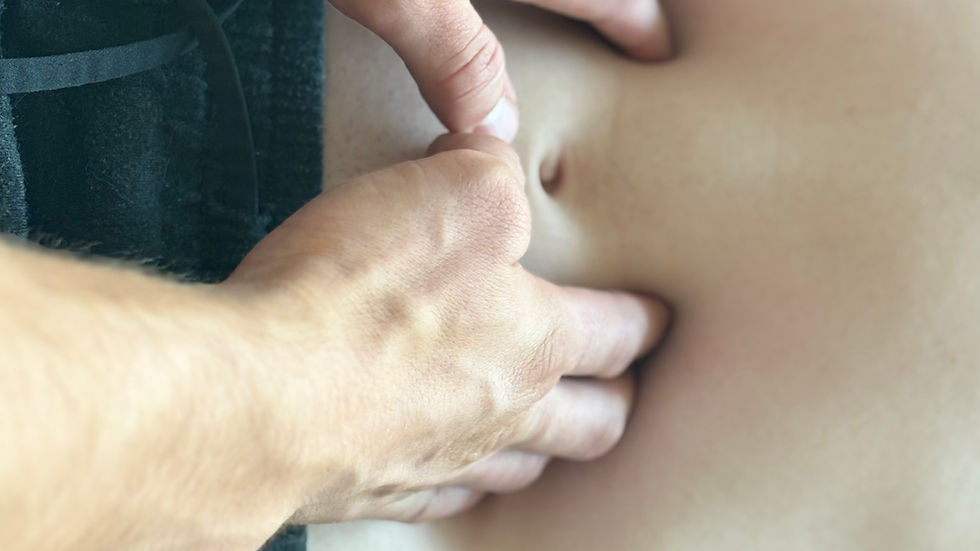Structural Integration: A Holistic Body Based Therapy
- somatichaa
- Jul 14, 2025
- 4 min read
Updated: Aug 5, 2025
The human body is composed of many systems that communicate 24/7. There are three major systems: the nervous, circulatory, and fibrous systems. Together, they provide a complete map of the human body and harbor intimate connections that play an integral part in one's perception of self (Myers 2021).
The Evolution of Cognitive Thinking
The recent evolutionary development of advanced cognitive thinking in humankind has led to significant technological advancements and improved community organization. However, this evolution has also had negative effects on self-embodiment. The rise of technology has separated cognitive thought from physical embodiment. In other words, the definition of self has become touchless. Moreover, modern ideas of self and treatment often overlook the fibrous body, focusing solely on the nervous and circulatory systems. Structural integration works to fill that gap.
The Importance of Physical Embodiment
The nervous system drives thoughts, the circulatory system drives emotions, and the fibrous system holds beliefs (Myers 2021). Any belief, unfinished action, or stored emotion manifests in the fibrous body. These areas are often neglected in the somatic map. Addressing them can be uncomfortable, but it can also lead to a sense of lightness and freedom when expressed successfully.
Structural integration (SI) aims to raise awareness of these closed-off areas and create ample space for change. This prepares clients to tackle unresolved actions or emotions. SI is a body-based therapy, and we will refer clients to talk therapy if desired. However, it is crucial that expression is not suppressed. Structural integration emphasizes feeling the body, expressing what arises, and being a catalyst for long-term change.
"Expression of unresolved energy is freeing; knowing why is the consolation prize."
The Connection Between Embodiment and Breath
An excellent example of unresolved energy leading to physical alteration is maladaptive breathing patterns. The following breath patterns developed over time in human biology to deal with threats or prepare for action (Gilbert 1998):
Holding Breath During a Freeze Response: Causes excessive muscular restriction and tension.
Thoracic Breathing in Response to Threat: Leads to shallow breathing and underuse of the diaphragm.
Mouth Breathing to Prepare for Action: Reduces filtered air intake into the lungs and promotes shallow breathing.
Increased Respiratory Depth and/or Rate: Induces carbon dioxide deficiency and temporary alkalosis during non-intense bouts of exercise.
These breathing patterns arise in times of threat. In the past, a threat would induce a specific breathing pattern that would resolve with a successful escape. In modern society, threats are perceived but often remain unresolved, leading to maladaptive patterns. Breath normality is rare due to chronic exposure to low-level threats, societal suppression of emotional expression, and the generalization of threat derived from intense events.
Understanding Generalization of Threat
Generalization of threat refers to classical conditioning. In classical conditioning, an unconditioned stimulus produces an unconditioned response. After the initial interaction, the unconditioned response becomes a conditioned response to the now conditioned stimulus. Generalization occurs when stimuli related to the original conditioned stimulus produce the same conditioned response.
An Example:
Consider John Doe, who was in a car accident. He reacted to the incident by mouth breathing, with shallow inhales and exhales. This response increased oxygen uptake and decreased carbon dioxide levels in an effort to physically mobilize. However, John was unable to escape the situation and felt anxious, afraid, and helpless. After the incident, every time he entered a car, his breathing pattern subconsciously returned to that of the accident, along with the associated emotions. Over time, John’s breathing pattern would trigger whenever he felt trapped, such as in crowded areas, airplanes, or during criticism.
This example illustrates how generalization occurs subconsciously, triggering emotions and physical states similar to the original event. These intense, emotionally charged states can develop into strongly held patterns that are subconsciously avoided, falling outside of the somatic map. In other words, they become beliefs in the fibrous body that influence actions, reactions, and perceptions of self. This also leads to physical alterations in alignment and reduces the integrity of the bio-tensegrity system of the human body.
Alteration of breath is just one aspect of how beliefs or unresolved energy can hold the body in the past, reducing physical and emotional adaptability.
The Structural Integration Approach to Embodiment
Structural integration fosters a more coherent sense of self and renewed ease of movement by addressing the fibrous body.

The fibrous body holds beliefs that consciously or subconsciously define who someone is. Many beliefs often fall outside the somatic map. Addressing these neglected areas can be the missing link to successfully resolving past anxiety, shame, or emotional turmoil. Structural integration aims to provide awareness and adaptability to the entire fibrous body, allowing individuals to develop a new sense of self by challenging what physically defines them.
Conclusion
In conclusion, understanding the connection between embodiment, breath, and the fibrous body is essential for achieving a holistic sense of self. By addressing these often-overlooked areas, individuals can unlock the potential for emotional healing and physical adaptability. Structural integration serves as a powerful tool in this journey, guiding clients toward a more integrated and fulfilling experience of self.
References
Gilbert, C., PhD (1998). Emotional Sources of Dysfunctional Breathing. Journal of Bodywork and Movement Therapies, 2(4), 224-230. https://doi.org/10.1016/S1360-8592(98)80019-380019-3)
Meyers, T. W. (2021). Anatomy Trains: Myofascial Meridians for Manual Therapists & Movement Professionals (4th ed.). Elsevier.




Comments